The Haggadah Collector Unveils a Rare Collection: "Every Haggadah Has Its Own Story"
The Holocaust-surviving Haggadah, the American-penned Haggadah, the handwritten one, and the one printed in Gush Katif. Collector Moshe Gan Tzvi reveals his rare Haggadah collection and the stories behind them.
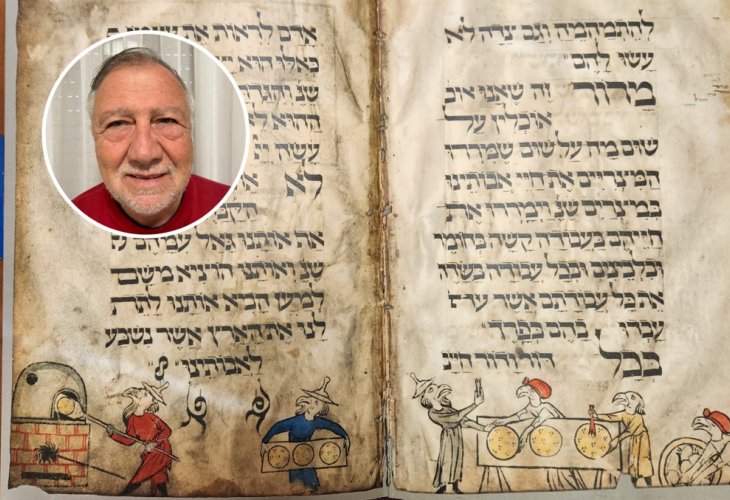 The Collector Moshe Gan Tzvi
The Collector Moshe Gan TzviThere are hundreds of Haggadot in the collection of Moshe Gan Tzvi, a collector residing in Haifa. For decades, he has been collecting them, integrating them, and most importantly, getting to know the fascinating stories that lie behind them.
"The Passover Haggadah is one of the most intriguing documents of Jewish culture," explains Gan Tzvi, as he grants us a glimpse into his unique collection. "It encompasses all our history, where families would come together and sit to celebrate the liberation of the Jewish people. While the text of the Haggadah has remained consistent over the years, each generation has its unique Haggadot that reflect the events of their times. The truth is, it's nothing short of fascinating."
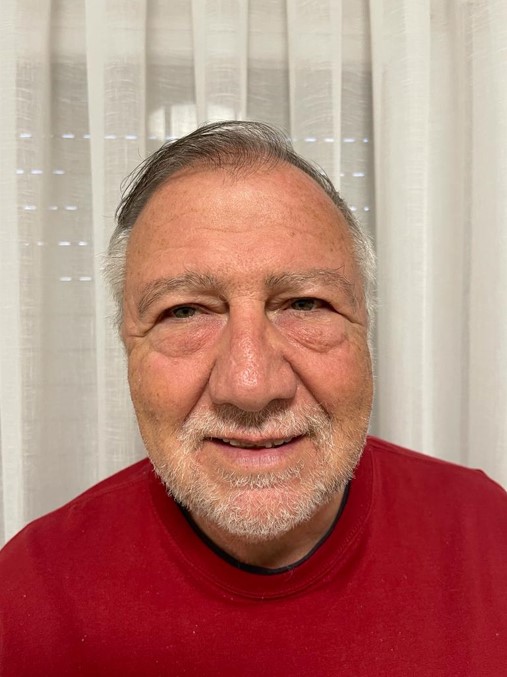
Haggadot Through the Ages
Gan Tzvi not only collects Haggadot but also delves into the extensive subject of the 'Passover Haggadah' and everything that preceded and led to its writing. "The first illustrated Haggadot appeared during the Geonic period, and from then on, they continued to be handwritten, passed from generation to generation," he explains, "even today, you can find handwritten Haggadot in museums, even relatively recent editions, because in Yemen, for example, they continued to handwrite Haggadot long after the invention of the printing press.
"But the biggest evolution in the world of Haggadot occurred with the invention of the printing press, which made them accessible to a much wider audience. Before that, not everyone could afford a Haggadah, and manuscripts were mainly in the possession of wealthy families. However, once printing began, Haggadot reached a broad distribution and the 'Passover Haggadah' took on a different dimension. I have a facsimile of one of the earliest printed Haggadot in my collection. It was printed in 1482 in Guadalajara, Spain. It is a very simple Haggadah that spans only seven pages, but what makes it unique is that it's printed.
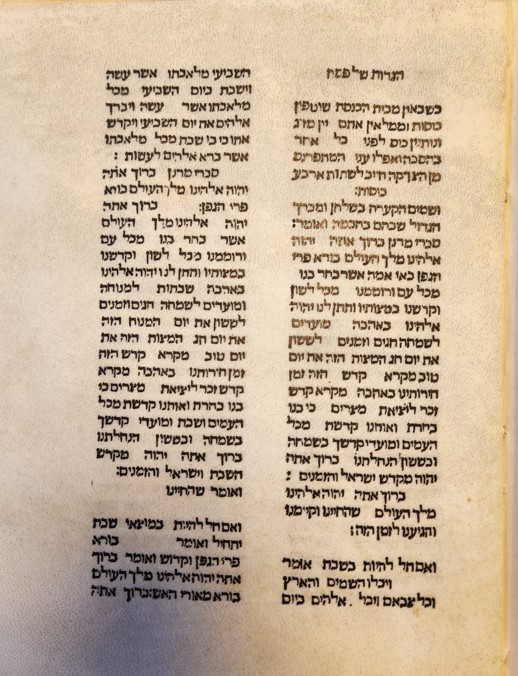 Facsimile of the first printed Haggadah, year 1482, Guadalajara, Spain.
Facsimile of the first printed Haggadah, year 1482, Guadalajara, Spain."Thanks to printing, written commentaries could also be added to the Haggadah. For example, there is a very ancient Haggadah called 'The Zevach Pesach Haggadah.' It's the Abarbanel's Haggadah, which presents a hundred questions on the Haggadah and, of course, provides answers. It is a very ancient text printed at the beginning of the 16th century.
"It is fascinating to see that over the years, Passover Haggadot were characterized by numerous illustrations and decorations, assuming they would help convey the message to children and family members, illustrating the Exodus from Egypt. There is a fascinating Haggadah printed at the end of the 13th century called 'The Bird's Head Haggadah.' It features human figures with bird heads and is considered the oldest complete Haggadah in existence, displayed at the Israel Museum. Over the years, many scholars have tried to explain why the Haggadah's illustrators chose bird illustrations, and there is substantial academic debate on the topic, with some claiming that Christians drew the illustrations as anti-Semitic cartoons. There is no definitive conclusion on the matter."
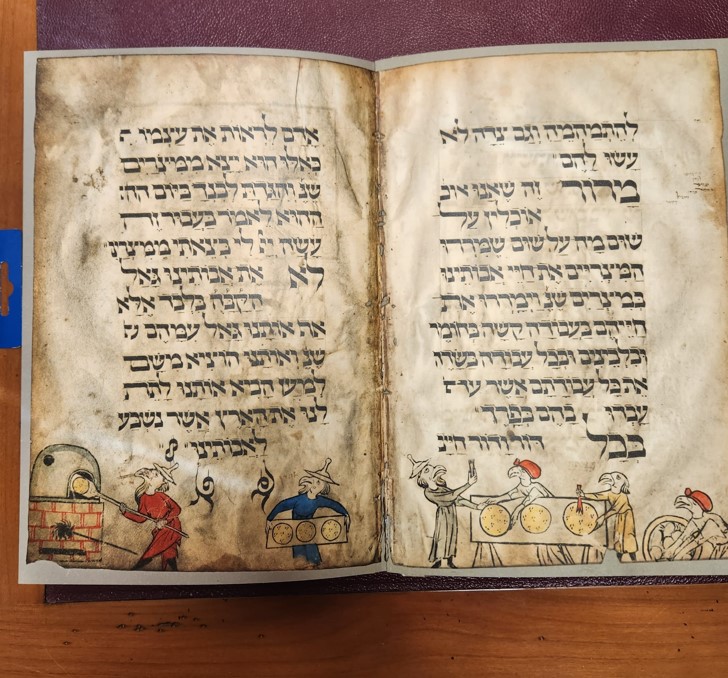 Facsimile of the Bird's Head Haggadah, manuscript end of the 13th century.
Facsimile of the Bird's Head Haggadah, manuscript end of the 13th century.Rare and Special
How many Haggadot do you have in your collection?
"I have several hundred Haggadot, but I don't count them. I prefer to focus on quality, not quantity."
But not every Haggadah makes it into his collection. "I only add Haggadot that truly speak to me," he clarifies, "primarily reflected in the period they were printed, but I also examine the editing, content, and design, as it reflects the essence.
"For example," he adds, "I have a Passover Haggadah from the Holocaust period. On the outside, it looks like a regular Haggadah, except that on the first page, there's a Nazi censorship stamp combined with a swastika.
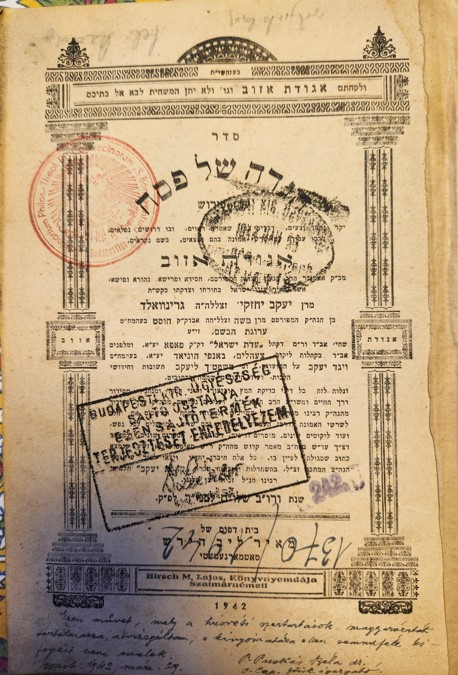 The 'Ezov Association Haggadah,' printed in Satmar, 1942. Nazi censor stamp on the opening page.
The 'Ezov Association Haggadah,' printed in Satmar, 1942. Nazi censor stamp on the opening page."Another Haggadah that significantly touched me is one written in the USA in 1942. It's all in shades of blue and blooming, reflecting hope and joy, with the background text 'We were slaves.' You can see slaves building skyscrapers in the USA. Interestingly, I have another Haggadah printed in the USA two years later, but the differences are monumental. The Haggadah from 1944 is in black and white, reflecting much sorrow and grief, replacing drawings of comfortable life in the USA with German soldiers.
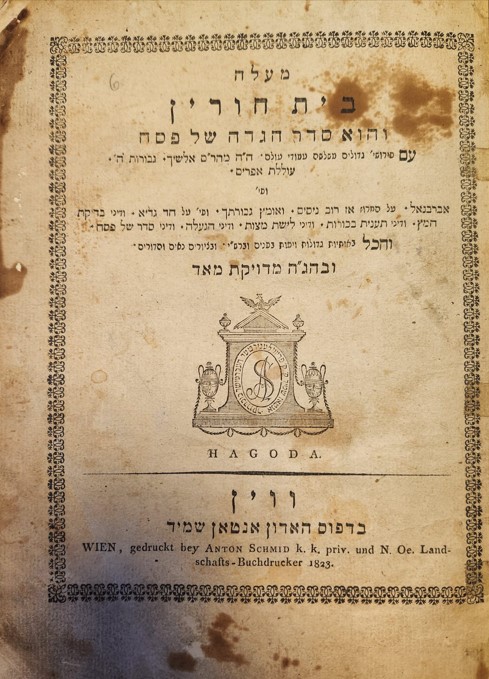 The 'Maale Beit Horin Haggadah,' Vienna, 1823.
The 'Maale Beit Horin Haggadah,' Vienna, 1823."I also have a Haggadah that is, in my opinion, very rare. It was printed for the last Passover in Gush Katif, about three months before the evacuation. It depicts Gush Katif, showing the agricultural activities and the never-ending work. Although people knew back then about the impending evacuation, they were still filled with hope and belief that the plan wouldn't materialize. This Haggadah was released as a one-time edition making it very rare.
"Incidentally, I also have a Haggadah from the period when there were discussions about the Golan Heights, and the famous slogan 'The People Are with the Golan' was published. In this Haggadah, the wise son is portrayed as a farmer cultivating vineyards, the wicked son as Assad, who was then massacring his people, and the simple son is seen against a backdrop of wind turbines. The deeper you delve into the Haggadot, the more you see the depth within them. It's amazing to realize that one Haggadah can contain all our history and current events."
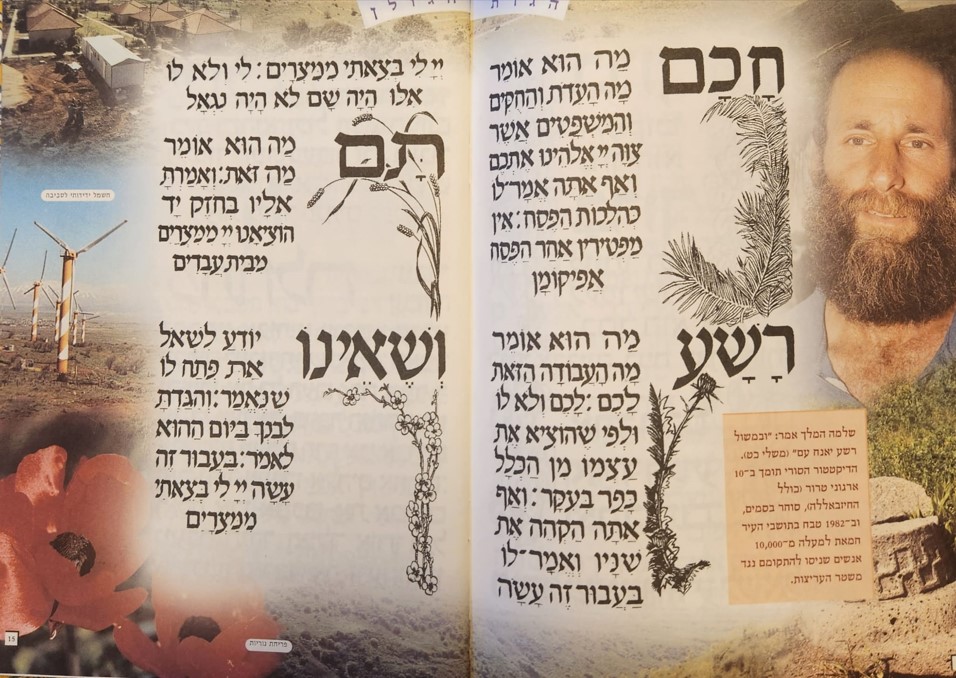 Photograph of the Four Sons in 'The People with the Golan' Haggadah, year 2000
Photograph of the Four Sons in 'The People with the Golan' Haggadah, year 2000
Making History
How do you acquire all these special Haggadot?
"They are truly very special Haggadot. Some I hear about and try to acquire. Some come to me through various events, and some people approach me asking to give them as gifts. Each Haggadah has its story, but what matters to me is that it's a family collection belonging to the family. It warms my heart every Passover night when the children and even grandchildren browse the Haggadot, showing interest and enjoyment."
 Facsimile of the Darmstadt Haggadah, manuscript ca. 1430.
Facsimile of the Darmstadt Haggadah, manuscript ca. 1430.And which Haggadah do you personally read on Passover night?
"I read the Haggadah I received from my parents during the first year of my marriage. It's the Haggadah that has accompanied me all these years, and I feel a special connection to every wine stain and wrinkle on it."
Gan Tzvi pauses for a moment and then adds emotionally, "But the most exciting moment for us on Passover night is just before starting the Seder. After coming back from the synagogue, the entire family stands together around the table, holding hands, and I tell the family the same phrase: 'Today, we sit and tell of the Exodus from Egypt. It may seem like we're recounting history, but in fact, we're making history ourselves. We are celebrating the 3335th anniversary of the Exodus from Egypt and thus are adding another link connecting the Jewish people. We are making history by simply being here at the Passover Seder. May we merit many more years of this.'"

